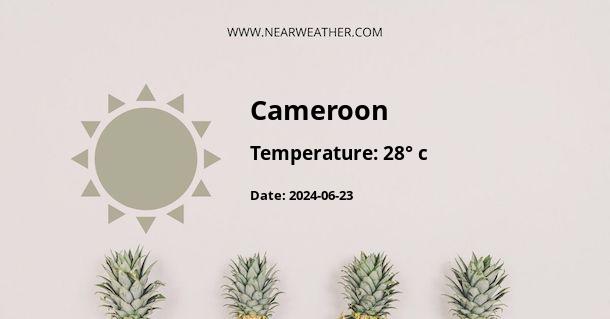Climate and Weather in the Republic of Cameroon
The Republic of Cameroon, located in Central Africa, experiences a diverse range of climates and weather patterns throughout the year. This West African country is known for its rich biodiversity, stunning landscapes, and unique cultural heritage. Understanding the climate and weather patterns in Cameroon is crucial for visitors and residents alike. Let's explore the different climatic zones and the weather conditions experienced in this beautiful country.
Climatic Zones
Cameroon is divided into four main climatic zones, each characterized by its own distinct weather patterns:
- Equatorial Zone: The equatorial zone covers the southern part of Cameroon, including the coastal areas and the dense rainforests. This region experiences high temperatures, high humidity, and abundant rainfall throughout the year. The average annual rainfall in this zone exceeds 2,000 millimeters (78 inches), making it one of the wettest regions in the world.
- Savannah Zone: The savannah zone stretches across the central part of Cameroon. It is characterized by a combination of grasslands, shrubs, and scattered trees. The climate in this zone is marked by a distinct wet and dry season. The wet season typically occurs from April to October, with precipitation ranging from 1,000 to 1,500 millimeters (39 to 59 inches) annually.
- Highland Zone: The highland zone covers the western part of Cameroon, including the famous Mount Cameroon. This region experiences a moderate climate due to its higher elevation. The temperatures are generally cooler than in other parts of the country, and rainfall is evenly distributed throughout the year. The average annual precipitation in the highland zone ranges from 1,500 to 2,000 millimeters (59 to 78 inches).
- Sahelian Zone: The Sahelian zone occupies the northern part of Cameroon, bordering the Sahara Desert. This region is characterized by a semi-arid climate with hot and dry conditions. The annual rainfall in this zone is relatively low, ranging from 500 to 800 millimeters (20 to 31 inches) and occurs mainly during the months of June to September.
Weather Patterns
Cameroon experiences a variety of weather patterns throughout the year. The following sections provide an overview of the weather conditions in each climatic zone:
Equatorial Zone
The equatorial zone in Cameroon is known for its consistently high temperatures and humidity levels. The average temperature remains around 25 to 30 degrees Celsius (77 to 86 degrees Fahrenheit) throughout the year. Heavy rainfall is a common occurrence, with the wettest months being from May to October. Thunderstorms are frequent, and the region experiences around 150 to 200 rainy days annually.
Savannah Zone
The savannah zone experiences distinct wet and dry seasons. During the wet season, temperatures remain relatively high, ranging from 25 to 35 degrees Celsius (77 to 95 degrees Fahrenheit). The dry season, which typically lasts from November to March, brings cooler temperatures ranging from 15 to 30 degrees Celsius (59 to 86 degrees Fahrenheit). Dust storms are occasionally experienced during the dry season.
Highland Zone
The highland zone in Cameroon enjoys cooler temperatures compared to the rest of the country. The average temperature ranges from 20 to 25 degrees Celsius (68 to 77 degrees Fahrenheit). Rainfall is evenly distributed throughout the year, with occasional fog and mist in the higher elevations. The weather in this region is generally pleasant, making it a popular destination for outdoor activities.
Sahelian Zone
The Sahelian zone in northern Cameroon experiences hot and dry weather conditions. Temperatures can reach up to 40 degrees Celsius (104 degrees Fahrenheit) during the hottest months. The dry season lasts for most of the year, with little to no rainfall. Dust storms and harmattan winds, originating from the Sahara Desert, are common during this period.
Best Time to Visit
The best time to visit Cameroon depends on the specific region and activities planned. Generally, the months of November to February are considered the most favorable for travel, as they fall within the dry season for most parts of the country. During this period, the weather is relatively cooler, and there is less rainfall, making it ideal for outdoor exploration and wildlife viewing.
For those interested in experiencing the lush greenery and vibrant wildlife of the equatorial zone, the months of June to October offer the highest rainfall and a more immersive rainforest experience. However, it's important to note that heavy rainfall during this period can sometimes lead to travel disruptions and limited accessibility to certain areas.
For hiking enthusiasts, the best time to climb Mount Cameroon in the highland zone is during the dry season, particularly from December to February, when the weather is cooler and there is less chance of rain.
Conclusion
The Republic of Cameroon offers a diverse range of climates and weather conditions throughout its various regions. From the humid rainforests of the equatorial zone to the arid landscapes of the Sahelian zone, each area presents unique experiences for visitors and residents alike. Understanding the climate and weather patterns in Cameroon is essential for planning a successful trip or adjusting to life in different parts of the country. Whether you prefer the lush greenery of the rainy season or the milder temperatures of the dry season, Cameroon has something to offer for everyone.
A - Cameroon's Latitude is 6.000000 & Longitude is 12.000000.
A - Weather in Cameroon is 33° today.
A - Climate Conditions in Cameroon shows scattered clouds today.
A - Humidity in Cameroon is 12% today.
A - Wind speed in Cameroon is 9.25 km/h, flowing at 5° wind direction. today.
